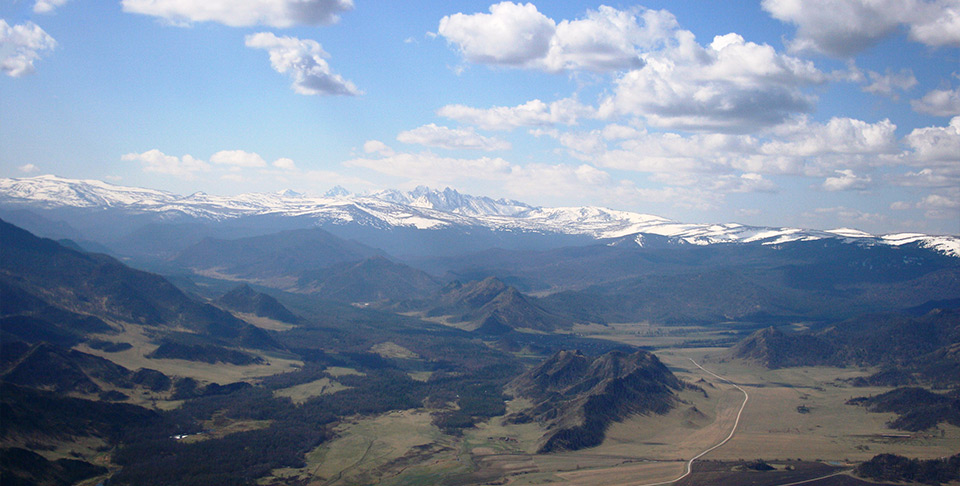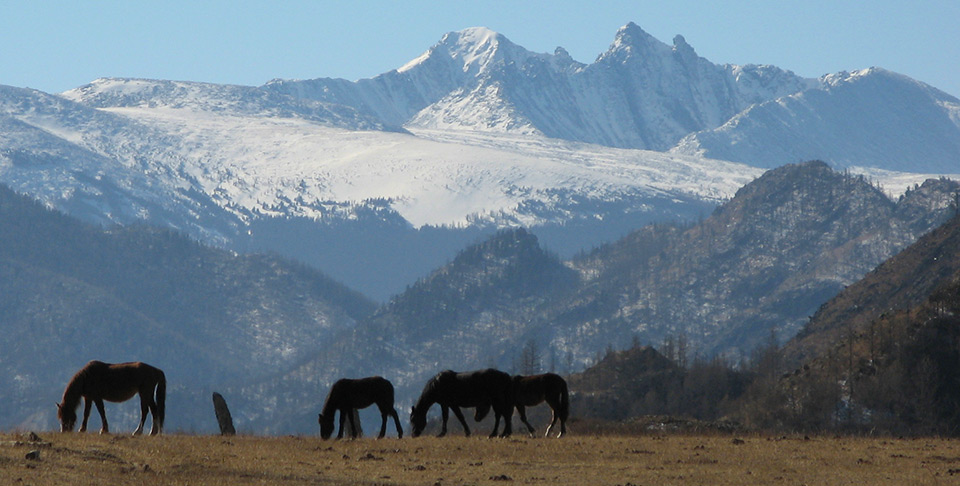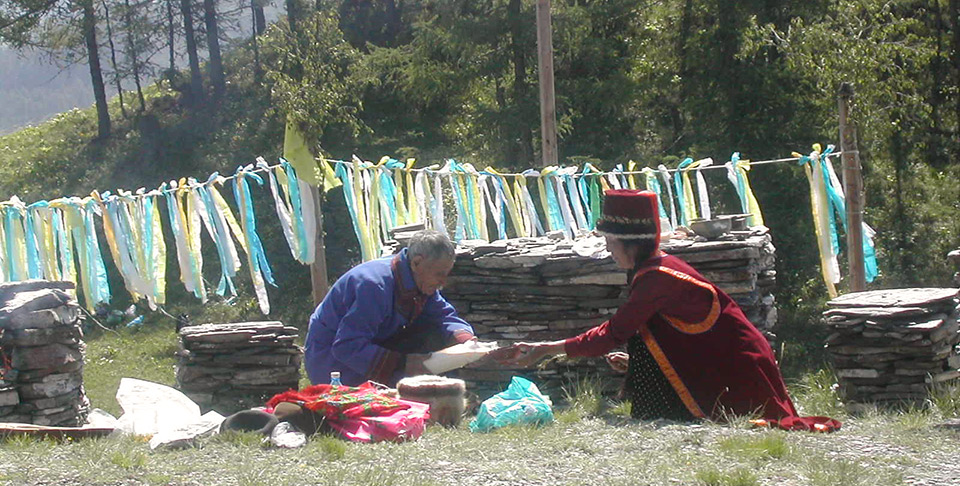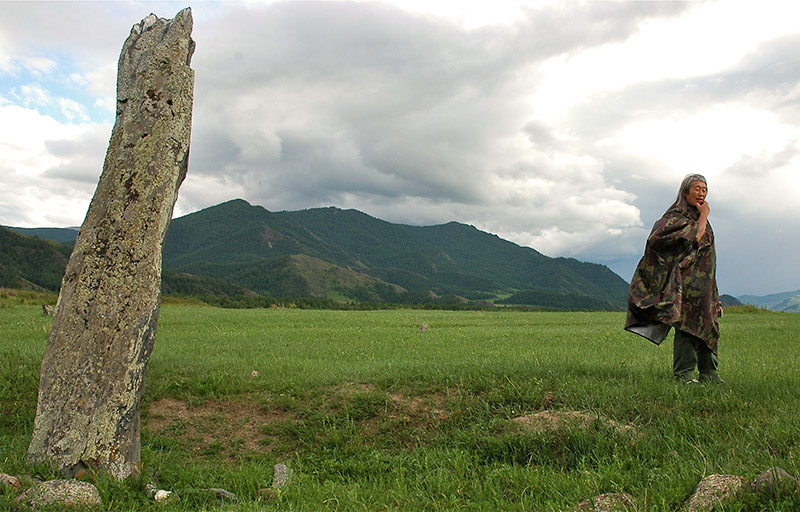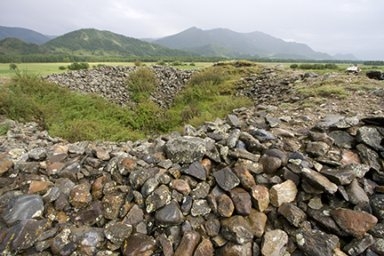અલ્તાઇ વિશ્વ દૃષ્ટિકોણમાં સમાયેલ ફિલસૂફી કુદરતી વસ્તુઓને ધ્યાનમાં લે છે (છોડ, પત્થરો, તારાઓ અને ગ્રહો) મનુષ્ય જેવા જ કાર્યાત્મક અંગોથી સંપન્ન જીવંત માણસો બનવા માટે. તદનુસાર, માઉન્ટ ઉચ્છ એન્મેકને પરંપરાગત રીતે પૃથ્વીની ‘નાભિ’ કહેવામાં આવે છે. માનવામાં આવે છે કે પૃથ્વીને આ નાભિ દ્વારા તે જ રીતે ગર્ભ દ્વારા માતાના ગર્ભાશયમાં પોષણ મળે છે તે જ રીતે આ નાભિ દ્વારા મહત્વપૂર્ણ energyર્જા અને જ્ knowledgeાન પ્રાપ્ત થાય છે.. કરાકોલ ખીણની પ્રાકૃતિક વિચિત્રતા ઉંચ એન્મેક પર્વતની આસપાસ છે, અલ્તાઇના સુવર્ણ પર્વતની સરહદ, તેની ભૌગોલિક રચનામાં આવેલું છે. ખીણ તેના ગૅબ્રો અને ડોલેરાઇટના વ્યાપક ઉત્પાદન માટે અનન્ય છે, ઉચ્ચ મેગ્નેટાઇટ ખનિજ સામગ્રી. ખીણ મધ્યમાં, આ આઉટક્રોપ્સ જે અનિવાર્યપણે મેગ્નેટાઇટની એક રિંગ છે જે ઈથરની ઊર્જાને પૃથ્વી તરફ આકર્ષિત કરવા માટે માનવામાં આવે છે.. આ પ્રદેશમાં ઘણી સ્થાનિક લાલ સૂચિ પ્રજાતિઓ છે, જેમ કે બ્લેક સ્ટોર્ક, મારલ રુટ અને સ્નો ચિત્તો.
ઇકોલોજી માટે ત્રણ મુખ્ય જોખમો ઓળખવામાં આવ્યા હતા, કારાકોલ ખીણ સાથે સંબંધિત સંસ્કૃતિ અને આધ્યાત્મિકતા.
તેઓ છે:
1) જમીન કાયદામાં ફેરફાર, જમીન કાર્યકાળ અને કુદરતી સંસાધન નીતિઓ,
2) અનિયંત્રિત સ્થાનિક અને આંતરરાષ્ટ્રીય પ્રવાસન અને માળખાકીય વિકાસમાં વધારો અને
3) વિકાસ દ્વારા પવિત્ર સ્થળોનો વિનાશ, ચોરી અને પુરાતત્વ.
ક્લાઈમેટ ચેન્જનો પણ ખતરો તરીકે ઉલ્લેખ કરવામાં આવ્યો છે, ખાસ કરીને સ્થાનિક ઇકોલોજી માટે. તાત્કાલિક ધમકીઓમાં રશિયન રાજ્ય કંપની ગેઝપ્રોમ દ્વારા ખીણમાંથી ગેસ પાઇપલાઇનનું નિર્માણ શામેલ છે..
પવિત્ર સ્થળોની વ્યવસ્થા તરીકે કારાકોલ ખીણ હાલમાં નિર્માણાધીન ગેસ પાઇપલાઇન દ્વારા જોખમમાં છે. કેટલીક પવિત્ર જગ્યાઓ સીધી રીતે જોખમમાં છે તેમજ લાલ લિસ્ટેડ પ્રજાતિઓ જેમ કે બરફ ચિત્તો
સંરક્ષકો
અલ્તાઇના સ્વદેશી લોકોની પરંપરાગત સંસ્કૃતિના નૈતિક સિદ્ધાંતો સદીઓથી વિકસિત થયા છે.. આ સિદ્ધાંતો કુદરતી સંસાધનોના ખાસ કરીને સાવચેતીપૂર્વક ઉપયોગની પૂર્વધારણા કરે છે. તેઓ ચોક્કસ ક્ષેત્રોના અસ્તિત્વને પણ સ્વીકારે છે જે માણસ અને પર્યાવરણ વચ્ચેના ઇકોલોજીકલ સંતુલનને ટેકો આપવા માટે મહત્વપૂર્ણ ભૂમિકા ભજવે છે.. આ જોડાણના સંદર્ભમાં સ્વદેશી રહેવાસીઓ આત્મા ઇકોલોજીની વાત કરે છે.
અલ્તાઇ સમુદાયોમાં શામન અને સમુદાયના વડીલો જેવા આધ્યાત્મિક નેતાઓ હોય છે. તેમ છતાં તેમની ફિલસૂફી મુજબ, વ્યક્તિગત જવાબદારી એ કુદરતી વિશ્વ સાથે સ્વદેશી સંબંધનું મુખ્ય તત્વ છે. કુદરતી વિશ્વ સાથેના સંબંધની જવાબદારી લેવી એ આધુનિક વિશ્વ માટે ઉચ્ચ મહત્વની ગણાય છે.
"પવિત્ર સ્થળો મનુષ્યોને જીવનની વધુ સમજણ માટે પડકારી રહ્યાં છે" - Danil Mamyev, પાર્ક મેનેજર અને પવિત્ર કુદરતી સ્થળ કસ્ટોડિયન.
દ્રષ્ટિ
સ્વદેશી પહેલ Uch Enmek ની વિશિષ્ટતા તેના પવિત્ર જ્ઞાનને પરંપરાગત જ્ઞાન અને સમકાલીન વિજ્ઞાન દ્વારા એવી ભાષામાં વ્યક્ત કરવાના પ્રયાસમાં રહેલી છે જે સમકાલીન સમાજો માટે સુલભ હોઈ શકે જેમણે જમીન સાથેનો તેમનો વિશેષ સંબંધ ગુમાવ્યો હોય.. એવી આશા છે કે ઉદ્યાનના વિઝનને ઉત્તેજિત કરવા માટે આંતરરાષ્ટ્રીય કુદરતી અને સાંસ્કૃતિક વારસો સમુદાય તરફથી સમર્થન પ્રાપ્ત થઈ શકે છે..
ક્રિયા
સ્થાનિક આધ્યાત્મિક નેતાઓ હવે પ્રવાસીઓને શિક્ષિત કરવા માટે પ્રવાસો આપે છે અને ખાતરી કરે છે કે તેઓ આ પ્રદેશમાં પવિત્ર કુદરતી સ્થળો દ્વારા માંગવામાં આવેલા નિયમો અનુસાર વર્તે છે.. પર્યટનના ઘટકોમાં 'કાઈ' ગળાના ગાયન પ્રદર્શનનો સમાવેશ થાય છે, રોક આર્ટ સાઇટ્સની મુલાકાત, કુર્ગન, ધાર્મિક સ્થળો અને પરંપરાગત અલ્તાઇ ભોજન. જ્યારે આદિવાસી લોકો ખીણની મુલાકાત લે છે ત્યારે તેઓ નકારાત્મક વિચારો અને લાગણીઓને એક બાજુ મૂકીને પોતાની જાતને આંતરિક રીતે તૈયાર કરે છે જે વાતાવરણની વિશેષ ગુણવત્તાને ‘પ્રદૂષિત’ કરી શકે છે.. નિયમ પ્રમાણે, મુલાકાતીઓને તે જ કરવા માટે આમંત્રિત કરવામાં આવે છે, ધ્યાન રાખવું કે તેમના વિચારો 'સફેદ' અને 'શુદ્ધ' હોય. બાકીના માટે Uch Enmek ની વર્તમાન પ્રવૃત્તિઓ મુખ્યત્વે સ્થાનિક શાળાઓ સાથે વૈજ્ઞાનિક સંશોધન અને જાગૃતિ વધારવાની પ્રવૃત્તિઓ સુધી મર્યાદિત છે..
નીતિ અને કાયદો
Uch Enmek એ પ્રાંત દ્વારા માન્યતા પ્રાપ્ત વિશેષ રીતે સુરક્ષિત કુદરતી ઉદ્યાન છે, પરંતુ રશિયન કાયદા દ્વારા નહીં. ઉદ્યાનની સ્થાપના સંબંધિત મૂળ શામન અને સ્થાનિક સમુદાયો દ્વારા તેમના આધ્યાત્મિક લેન્ડસ્કેપ અને કુદરતી સંસાધનોને બહારના હિતોથી બચાવવા માટે કરવામાં આવી છે., ઉદ્યાનનો એક ભાગ યુનેસ્કો મેન અને બાયોસ્ફિયર રિઝર્વ છે. આ રક્ષણ 'અલ્તાઈ રિપબ્લિકમાં વિશેષ રીતે સંરક્ષિત પ્રકૃતિ પ્રદેશો અને સાઇટ્સ' નામના કાયદા પર આધારિત છે. તેમાં ત્રણ ઝોન છે.. ઝોન A એ 'ન્યુક્લિયસ' છે, સમાવતી 810 હેક્ટર પવિત્ર પ્રદેશ. ઝોન B એ બફર ઝોન છે. તેમાં ઐતિહાસિક અને સાંસ્કૃતિક સ્મારકોનો સમાવેશ થાય છે. મર્યાદિત ઍક્સેસ આપવામાં આવે છે, શામનિક ધાર્મિક વિધિઓ અને વૈજ્ઞાનિક સંશોધનો માટે કડક રીતે નિયંત્રિત મુલાકાત સાથે. ઝોન C એ વિકાસ ક્ષેત્ર છે, ગામડાઓ અને ખેતીની જમીનો ધરાવે છે, જ્યાં સક્રિય સંરક્ષણ થાય છે. 30 પાર્કનો ટકા હિસ્સો સત્તાવાર રીતે ખેડૂતોની માલિકીનો છે, 70 ટકા અનરજિસ્ટર્ડ રહે છે.
સંયુક્ત
સેક્રેડ વેલી અને નીચે વર્ણવેલ સ્વદેશી સંસ્કૃતિ સામેના જોખમોના પ્રતિભાવ તરીકે ઉચ એનમેક સ્વદેશી પહેલે માઉન્ટ ઉચ એનમેકના નામ પરથી પાર્કની સ્થાપના કરી છે.. પહેલનો ઉદ્દેશ પર્યાવરણીય અને સાંસ્કૃતિક પરિસ્થિતિ પર સંશોધન કરવાનો છે, પ્રકૃતિ સંરક્ષણ અને દેખરેખ કાર્યક્રમોનો અમલ, સ્થાનિક ઇકોલોજી પર જાગરૂકતા વધારવી અને પાર્ક મેનેજમેન્ટમાં આધ્યાત્મિક અને નૈતિક માર્ગદર્શન વિકસાવવું. ગઠબંધન અલ્તાઇના ટકાઉ વિકાસના ફાઉન્ડેશન દ્વારા સમર્થિત છે અને સેક્રેડ નેચરલ સાઇટ્સ ઇનિશિયેટિવ નામની ઘણી સંસ્થાઓના જોડાણ દ્વારા આંતરરાષ્ટ્રીય સમર્થન આપવામાં આવે છે., ગૈયા ફાઉન્ડેશન અને સેક્રેડ લેન્ડ ફિલ્મ પ્રોજેક્ટ.
સંરક્ષણ સાધનો
સ્વદેશી આધ્યાત્મિકતા પર આધારિત ઇકોલોજીકલ એથિક્સ માટે વિશેષ શાળાની રચના દ્વારા શિક્ષણ એ સંરક્ષણ પ્રાપ્ત કરવા માટે એક અસરકારક સાધન છે.. માર્ગદર્શિત તીર્થયાત્રા પવિત્રની જાગૃતિ વધારવામાં ફાળો આપે છે, સાઇટના સાંસ્કૃતિક અને જૈવિક ગુણો. વધુમાં, માર્ગદર્શિકા આ સાઇટ્સના આધ્યાત્મિક અને નૈતિક સંચાલન માટે વિકસાવવામાં આવી છે. સંરક્ષણમાં વપરાતી વ્યૂહરચનાઓમાંની એક સ્થાનિક આધ્યાત્મિક માન્યતાઓનું આયોજન અને સંચાલનમાં વપરાતી વૈજ્ઞાનિક ભાષામાં અનુવાદ છે.. નકશા પૃથ્વીના ચુંબકીય ક્ષેત્ર પર ખોદકામની ઘટતી અસરને દર્શાવે છે, જે સ્થાનો આધ્યાત્મિક મૂલ્યનું મુખ્ય પાસું હોવાનું માનવામાં આવે છે.
પરિણામો
ક્રિયાઓના પરિણામો વૈજ્ઞાનિક ભાષામાં અનુવાદિત સ્થાનિક કોસ્મોવિઝનના ડેટાબેઝ અને સ્થાનિક ચુંબકીય ક્ષેત્રો પરના કેટલાક ડેટાને સમાવે છે.. મુલાકાતીઓ અને સ્થાનિકોએ પરંપરાગત મૂલ્યો અને માન્યતાઓ વિશે પણ જાગૃતિ મેળવી છે. આ માન્યતાઓની જાગૃતિ કરી શકે છે, જો કે, હજુ સુધી હિસ્સેદારો દ્વારા ઉભા થતા સતત જોખમોનો સંપૂર્ણ સામનો નથી કર્યો. યુનેસ્કોએ મેન એન્ડ બાયોસ્ફિયર રિઝર્વમાં મિશનને સમર્થન આપ્યું છે અને સ્થાનિક એનજીઓ પ્રાકૃતિક અને સાંસ્કૃતિક બંને માપદંડોના આધારે વિશ્વ ધરોહર સ્થળ તરીકે બૃહદ કરાકુલ ખીણને માન્યતા આપવા દબાણ કરી રહ્યા છે., પ્રક્રિયાને વર્તમાન સરકાર તરફથી થોડો ટેકો મળે છે.
"આદેશી લોકોના પરિપ્રેક્ષ્ય દ્વારા શિક્ષણનો વિકાસ કરવો ખૂબ જ મહત્વપૂર્ણ છે... ...આપણે એક જવાબદાર અને મહત્વપૂર્ણ સમયમાં જીવીએ છીએ કારણ કે એક જીવંત જીવ તરીકે પૃથ્વી ચોક્કસ વયે પહોંચી ગઈ છે... ...એવી માનવતા પહોંચી ગઈ છે જે સ્વદેશી લોકોની ભાષા દ્વારા વિશ્વને સમજવા માટે તૈયાર છે".
- Danil Mamyev, પાર્ક મેનેજર અને પવિત્ર કુદરતી સ્થળ કસ્ટોડિયન 2012.
ડાબે: અલ્તાઇના સુવર્ણ પર્વતોમાં ઉચ એનમેક ખાતે ખોદાયેલ કુર્ગન અથવા પ્રાચીન દફન સ્થળ. અલ્તાઇમાં પ્રાચીન દફન સ્થળોની અપવિત્રતા એ એક સામાન્ય ઘટના છે, અવશેષો કાળા બજારમાં વેચાય છે. (સોર્સ: ફ્રેડિયાની જે. 2008.)
- ડોબસન જે., મામયેવ, ડી, (2010) સેક્રેડ વેલી, સંરક્ષણ વ્યવસ્થાપન અને સ્વદેશી સર્વાઇવલ: ઉચ એનમેક સ્વદેશી પ્રકૃતિ ઉદ્યાન, અલ્ટાઇ રિપબ્લિકે, રશિયા, Verschuuren માં, બી, વાઇલ્ડ આર, McNeeley, J. અને ઓવીઇડો., જી. પવિત્ર કુદરતી Sites, કુદરત અને સંસ્કૃતિ સંરક્ષણ, પૃથ્વી સ્કેન, લન્ડન,.પીપી. 244-354.
- યુનેસ્કો (1998) અલ્તાઇના સુવર્ણ પર્વતો, વર્લ્ડ હેરિટેજ શિલાલેખ, વેબસાઇટ ની મુલાકાત લો
- પૃથ્વીને ભેટી: સ્વદેશી ઉપચારકો જેજુ ખાતે ભેગા થાય છે, દક્ષિણ કોરિયા, 2012: વિડિઓ જુઓ
- પવિત્ર ભૂમિ ફિલ્મ પ્રોજેક્ટ (2011): "અલ્તાઇ પાઇપલાઇન આગળ વધે છે": વેબસાઇટ ની મુલાકાત લો
- પવિત્ર ભૂમિ ફિલ્મ પ્રોજેક્ટ (2012) "સુવર્ણ પર્વતો": વેબસાઇટ ની મુલાકાત લો
- અલ્તાઇ પ્રોજેક્ટ; Ukok બંધ પાઇપલાઇન્સ રાખવા, વેબસાઇટ ની મુલાકાત લો
- અલ્તાઇ સહાય પ્રોજેક્ટ: પર્વત અલ્તાઇના પર્યાવરણ અને સમુદાયોના સંરક્ષણ અને વિકાસમાં મદદ કરવા: વેબસાઇટ ની મુલાકાત લો

